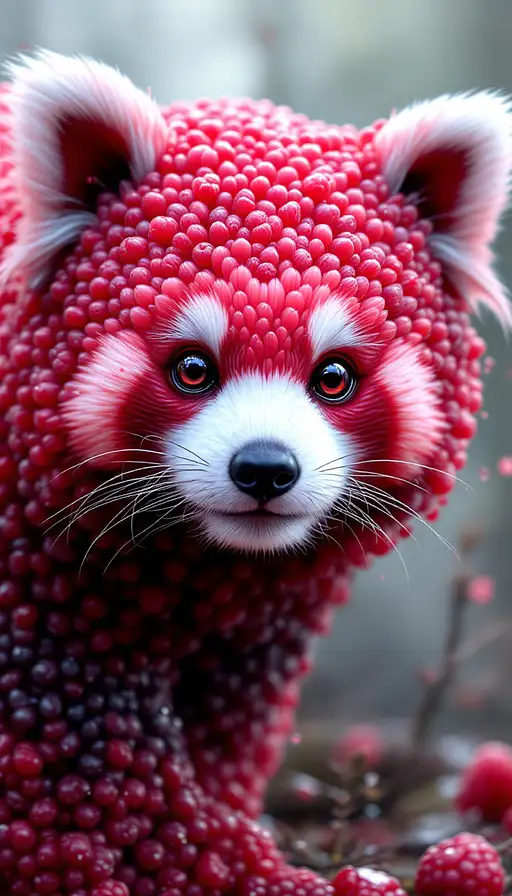
8 months ago
Create a hyper-realistic and intricately detailed depiction of a Red Panda, entirely sculpted from the juicy, vibrant flesh of fresh raspberries. The panda should look as if it were made of overlapping, translucent raspberry segments, with hues ranging from deep magentas and reds to softer pinks and whites. The raspberry flesh should look naturally glossy and moist, reflecting light and giving the panda an almost lifelike, fresh appearance. Each raspberry segment should have a slight translucency, with tiny droplets of juice adhering to the surface, adding to the realism. The texture of the fruit should replicate the soft, fluffy appearance of a red panda’s fur, giving the creature a rich, velvety look. Tiny raspberry seeds should be visible on its body, creating a natural, speckled texture that enhances the hyper-realistic quality. The panda’s face should be detailed with smooth, glossy raspberry segments, forming the soft curves of its cheeks, snout, and eyes. Its large, expressive eyes should be made from the pale pink core of the raspberry, reflecting the light around it with a deep, serene, yet curious expression. The eyes should have a glossy sheen, making them appear lifelike, and their dark pupils should stand out against the vibrant raspberry flesh. The panda’s ears should be delicate, formed from thin, translucent raspberry membranes, glowing softly and mimicking the panda's natural ear structure with an ethereal quality. The panda’s snout and nose should be sculpted from darker, richer raspberry segments, subtly mimicking the natural shades of the panda’s face. A small drop of juice should rest at the tip of its nose, emphasizing the moist, fresh texture of the fruit. The red panda’s fur pattern, with its signature face markings, should be replicated through the different shades of raspberry flesh, with darker reds around the eyes and on the snout, and lighter pinks and whites along the cheeks and chest. The red panda’s body should be made of overlapping raspberry segments, forming the soft contours of its fur. The segments should flow seamlessly, capturing the panda’s body’s natural curves, with subtle folds and bends that reflect its playful and relaxed posture. The panda’s limbs should also be formed from smaller, curved raspberry pieces, with the small raspberry seeds adding a natural texture that mimics the panda’s paws and limbs. The paws should be delicate, with subtle details to represent its claws, and tiny droplets of juice should cling to the tips of the paws, adding realism and freshness. The tail should be large and bushy, composed of overlapping layers of raspberry segments, creating a soft, fluffy texture. The tail should curl naturally around the panda’s body or drape down over the tree branch, with juice collecting in the crevices between the raspberry segments. The tail’s texture should resemble the fluffy, layered fur of a real red panda, with each segment of fruit adding volume and depth to the tail’s appearance. The red panda is perched comfortably on a tree branch, deep in the forest. The branch should be gnarled and textured, with soft moss growing along its surface. The branch is surrounded by thick, vibrant green foliage, with patches of moss, ferns, and small wildflowers along the forest floor. The tree branch should be thick and stable, just wide enough to hold the panda’s delicate body. The natural environment should be alive with rich detail. The forest should feel dense and lush, with towering trees covered in moss and lichen. The canopy above should filter soft, diffused light through its leaves, creating dappled patterns of light and shadow on the forest floor and the red panda. Light raindrops should be falling gently from the trees, and the moist droplets should cling to the panda’s raspberry-covered body, enhancing the fresh, dewy look. The misty atmosphere should be thick with the scent of wet earth, with faint wisps of mist swirling around the tree trunks. The panda should appear completely at ease, its delicate body blending into the surrounding environment. The lighting should be soft, with light filtering through the canopy to illuminate the red panda, creating natural highlights and shadows on its raspberry flesh. The rain should be visible in the air, with each droplet sparkling as it catches the light. The surrounding environment should be lush and wet, with the wet forest floor covered in moss, ferns, and fallen leaves. The overall atmosphere should be peaceful and serene, blending the vibrant, juicy texture of raspberry flesh with the red panda’s natural beauty and playful yet tranquil presence. The setting should evoke a sense of calm and natural wonder, with the panda resting comfortably on the tree branch, surrounded by the lush, dewy forest.




